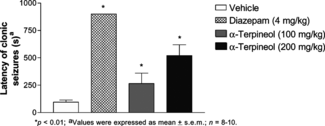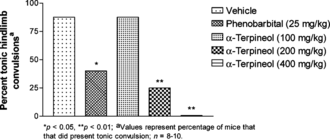Abstract
α-Terpineol, a monoterpenoid alcohol, was investigated for its anticonvulsant activity. This compound increased the latency to convulsions induced by pentylenetetrazole at doses of 100 and 200 mg/kg and decreased the incidence of hindlimb extension produced by MES in a dose-related manner at doses of 200 and 400 mg/kg.
Introduction
Many essential oils are known to have anticonvulsant activity (Almeida et al., Citation2003), probably due to terpenes that are the main constituents. This notion is supported by previous studies that showed that some monoterpenes present in many essential oils possess anticonvulsant activity in animal experiments, such as linalool (Elisabetsky et al., Citation1995), citral, β-myrcene, and limonene (Viana et al., Citation2000).
α-Terpineol is a volatile monoterpenoid alcohol and component of the essential oils of several species of plants (Dagne et al., Citation2000; Golshani et al., Citation2004; Raina et al., Citation2004). This compound is widely used in the perfumery, cosmetic, and soap industries. It is also used as a scenting agent in household products (e.g., disinfectant sprays) (Craveiro et al., Citation1981). The current investigation was carried out to evaluate the anticonvulsant activity of α-terpineol.
Materials and Methods
Animals
Male Swiss mice (28–35 g) were obtained from our research animal house. The animals were maintained at constant room temperature (27 ± 1°C) and on a 12/12 h light-dark cycle (light from 0600 to 1800 h), with free access to food and water. All behavioural observations were conducted between 1300 and 1800 h.
Drugs
Pentylenetetrazole (PTZ), Phenobarbital, and diazepam (DZP) were purchased from Sigma Chemical Co. St. Louis, M., (USA). (±)-α-Terpineol was purchased from Dierberger (João Pessoa, Brazil) and dissolved in 5% Tween 80 as an emulsion.
Anticonvulsant screening
Pentylenetetrazole-induced convulsions
Mice were divided into four groups. The first group served as control and received Tween 80, and the second group was treated with DZP (4 mg/kg). The remaining groups received an injection of α-terpineol at doses of 100 and 200 mg/kg. Thirty minutes after drug administration, the mice were treated with PTZ (i.p.) at a dose of 60 mg/kg and observed for at least 15 min to detect the occurrence of the first episode of forelimb clonus (Swinyard et al., Citation1989).
Maximal electroshock test
Mice were divided into five groups. The first group served as control and received Tween 80, and the second group was treated with phenobarbital (25 mg/kg). The remaining groups received an injection of α-terpineol at doses of 100, 200, or 400 mg/kg of α-terpineol (i.p.). Thirty minutes after treatment, mice received an electroconvulsive shock (130 V, 150 pulses/s, 0.5 s) through auricular electrodes to induce tonic hindlimb extension (THE). The number of animals showing tonic convulsions, characterized by the presence of THE, was observed (Oliveira et al., Citation2001).
Statistical analysis
The results were analyzed by means of variance analysis followed by Dunnet's test or Fisher's exact test. A probability level of 0.05 was accepted as significant.
Results
Two experiments were carried out on the effects of α-terpineol on anticonvulsant activity.
Pentylenetetrazole-induced convulsions
In the first experiment, α-terpineol increased the latency time of convulsions induced by PTZ at the dose of 200 mg/kg, using as drug pattern DZP (4 mg/kg) compared with control ().
Maximal electroshock test
α-Terpineol produced a dose-dependent protection against the maximal electroshock seizure pattern test, reaching maximum at 400 mg/kg (). The reference drug phenobarbital (25 mg/kg) also produced a significant protection.
Discussion
The anticonvulsant activity of α-terpineol was investigated in mice using chemical (pentylenetetrazole-induced convulsions) and physical (maximal electroshock test) animal models. As shown in , α-terpineol at doses of 100 and 200 mg/kg was effective to induce a significant increase of the latency in PTZ-induced convulsions. In this model, DZP (4 mg/kg), a standard drug, produced a greater increase of the latency. Complete protection against convulsions was observed in the maximal electroshock test. Interestingly, the α-terpineol was also effective in preventing tonic convulsions showing dose-dependent protection. As shown in , at dose of 400 mg/kg, it afforded 100% protection, and phenobarbital (25 mg/kg) was used as a positive control.
The fact that α-terpineol is a relatively common monoterpene and is present in many aromatic and medicinal plants shows the importance of studying the potential of this compound as an anticonvulsant drug. The current study provides evidence that α-terpineol has anticonvulsant activity, as shown in chemical and physical tests.
References
- Almeida RN, Motta SC, Leite JR (2003): Essential oils with anticonvulsant properties. Bol Latinoam Caribe Plantas Med Aromat 2: 3–6.
- Craveiro AA, Fernandes AG, Andrade CHS, Matos FJA, Alencar JW, Machado MIL (1981): In: Óleos Essenciais de Plantas do Nordeste. Fortaleza,pp. 44–209.
- Dagne E, Bisrat D, Alemayehu M, Worku T (2000): Essential oils of twelve Eucalyptus. species from Ethiopia. J Essent Oil Res 12: 467–470.
- Elisabetsky E, Coelho de Souza GP, Santos MAC, Siqueira IR, Amador TA (1995): Sedative properties of linalool. Fitoterapia 66: 407–414.
- Golshani S, Karamkhani F, Monsef-Esfehani HR, Abdollahi M (2004): Antinociceptive effects of the essential oil of Dracocephalum kotschyi. in the mouse writhing test. J Pharm Pharm Sci 7: 76–79.
- Oliveira FA, Almeida RN, Sousa MFV, Barbosa-filho JM, Diniz SA, Medeiros IA (2001): Anticonvulsant properties of N.-salicyloyltryptamine in mice. Pharmacol Biochem Behav 68: 199–202.
- Raina VK, Kumar A, Srivastava SK, Syamsundar KV, Kahol AP (2004): Essential oil composition of “kewda” (Pandanus odoratissimus.) from India. Flavour Frag J 19: 434–436.
- Swinyard EA, Woodhead JH, White HS, Franklin MR (1989): Experimental selection, quantification and evaluation of anticonvulsants. In: Levy RH, Dreyfuss FE, Mattson RM, Meldrum BS, Penry JK, eds., Antiepileptic Drugs. New York, Raven Press, pp. 85.
- Viana GSD, Vale TG, Silva CMM, Matos FJD (2000): Anticonvulsant activity of essential oils and active principles from chemotypes of Lippia alba. (Mill.) ne Brown. Biol Pharm Bull 23: 1314–1317.

